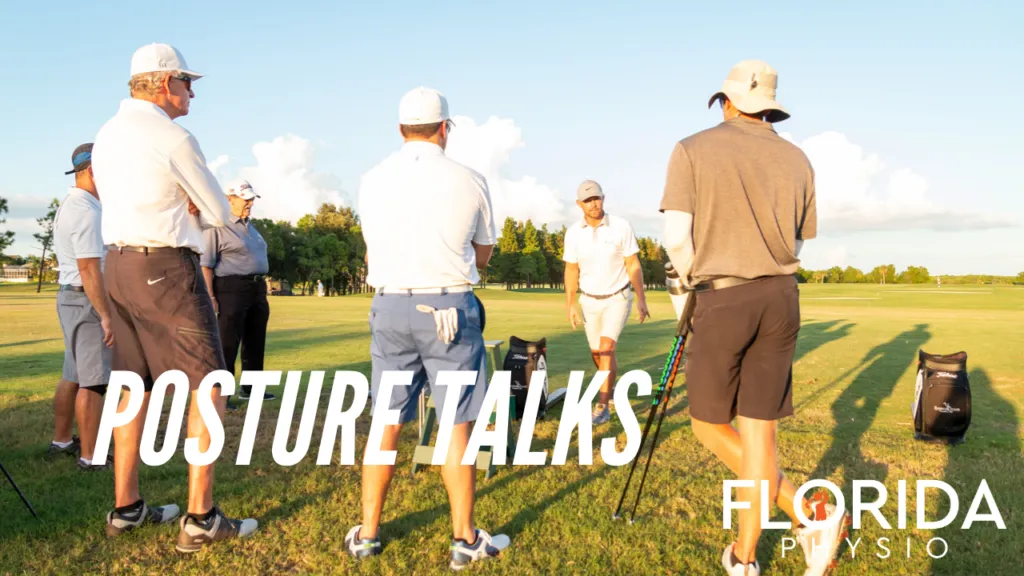Stop Blaming Posture for Your Golf-Related Joint Pain [Listen to the podcast]
With the emergence of a strong body of literature in the rehab world that basically debunks the “poor posture” myth. There is a growing group of modern physical therapists who worry less about posture more about the adage “the best posture is the next posture.”
I think we can take a little bit of this as it relates to “golf address posture.” Tommy Fleetwood has a C-Posture, Adam Scott has been in and out of that classic S-posture, and the exciting Matthew Wolff has quite the dynamic setup at address.
One of the first exam tests I learned in physical therapy school was the “plumb line screen.” It’s a static posture assessment related to where one’s head is in relation to shoulders, shoulders in relations to spine, spine in relation to hips, knees, feet and so on. This screen came with a nice picture of Janda’s upper and lower crossed syndrome with an elaborate explanation from a professor about “tight muscles here creates weakness in muscles here, etc…”
I remember feeling excited, this concept was an explanation dream that fulfilled my own confirmation bias. “So I just stretch what’s tight, and strengthen what’s weak and I’ll heal everyone!”“
Good” posture had been explained to me time and time again from when I was at a young age and even through my undergraduate exercise science program…now I had a name to call it and clinical doctoral-level education to substantiate it.
Wow, were my school teachers, professors, and own mother incredibly wrong. Muscle imbalance theories (Janda and others) have not done well in rigorous academic and clinical research. Time and time again there is poor reliability in our ability to assess postures and poor correlation with pain and function (1-7). There really is no data to support these ideas. Labeling people with upper or lowered crossed syndrome and attempting to treat it in the same nomenclature (stretch what’s tight, strengthen what’s weak) doesn’t work any better than generally getting more exercise.
In fact, I’d argue using the upper and lower crossed nomenclature with our clients could be considered malpractice by today’s evidenced informed standards. There is an emerging body of literature revealing the magnitude of nocebo effects on pain and function (8). Nocebo, simply put, is if we say something negative about somebody’s body (i.e. posture in the context of this blog post), it impacts the degree of pain and function they are experiencing. Imagine the nocebo implications as a golf instructor when trying to help a guy improve his game and there aren’t any “compliment sandwiches”…that’s another conversation for another day.
So, let’s fast forward 2.5 years of PT school and 6 years of orthopedic clinical practice later, I was sitting in the Titleist Performance Institute certification seminar in Orlando on the morning of Day 1. I arrived early and started flipping through the seminar manual placed on my chair. I chuckled and had a huge facepalm as the first few pages discussed Janda’s upper and lower crossed syndrome. Furthermore, one of the first screen tests we learned through the Titleist Performance Institute was the “Setup Posture Screen.” It’s a static golf posture assessment where the clinician tries to determine if the client falls into 1 of 3 posture groups (S-Curve, C-Curve, or Neutral).
If we consider what the evidence has shown time and time again about posture/position in the musculoskeletal research combined with the fact that “nocebo” language directly impacts are clients nervous system, function, and pain…should we be even looking at this?
I get it, the screen is a screen. It starts with the lens nice and wide and narrows in on problem areas. I use it almost daily. The whole point of this in the golf rehab and performance realm is to get away from labeling static positions because it’s hard to be reliable, creates nocebo, potentially increase posture fear and catastrophization.
Check out our podcast we did with Par Four Performance talking more about posture.
References:
- Fedorak C, Ashworth N, et al. Reliability of the visual assessment of cervical and lumbar lordosis: how good are we? Spine 2003; 28: 1857-1859.
- Roffey DM, Wai EK, Bishop P. Causal assessment of awkward occupational postures and low back pain: results of a systematic review. The Spine Journal 2010: 10; 89-99.
- Youdas JW, Garrett TR, Egan KS, et al. Lumbar Lordosis and Pelvic Inclination in Adults With Chronic Low Back Pain. Physical Therapy2000: 80; 261-275.
- Barrett E, O’keeffe M, O’sullivan K, Lewis J, Mccreesh K. Is thoracic spine posture associated with shoulder pain, range of motion and function? A systematic review. Man Ther. 2016;26:38-46. (https://www.ncbi.nlm.nih.gov/pubmed/27475532)
- Dolphens M, Cagnie B, Coorevits P, et al. Sagittal standing posture and its association with spinal pain: a school-based epidemiological study of 1196 Flemish adolescents before age at peak height velocity. Spine. 2012;37(19):1657-66. (https://www.ncbi.nlm.nih.gov/pubmed/22108378)
- Christensen ST, Hartvigsen J. Spinal curves and health: a systematic critical review of the epidemiological literature dealing with associations between sagittal spinal curves and health. J Manipulative Physiol Ther. 2008;31(9):690-714. (https://www.ncbi.nlm.nih.gov/pubmed/19028253)
- Villumsen M, Samani A, Jørgensen MB, Gupta N, Madeleine P, Holtermann A. Are forward bending of the trunk and low back pain associated among Danish blue-collar workers? A cross-sectional field study based on objective measures. Ergonomics. 2015;58(2):246-58. (https://www.ncbi.nlm.nih.gov/pubmed/25374330)
- Petersen GL, Finnerup NB, Colloca L, et al. The magnitude of nocebo effects in pain: a meta-analysis. Pain. 2014;155(8):1426–1434. doi:10.1016/j.pain.2014.04.016


